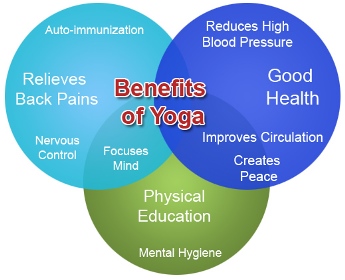SCIENCE CONFIRMS: YOGA IS GOOD FOR HEALTH

Over 20 million people practice yoga daily in the US. This popularity is unprecedented and increasing worldwide. Is there any science behind yoga? Should you be practicing yoga for your health? Yes, and yes.
Harvard researcher Dr. Khalsa points out that systematic education for psychological health is lacking in schools and society, for dealing with stress, emotion, attachment, grief, tension, and the wide array of associated physical symptoms1. So we are burdened with dysfunctional attitudes, maladaptive behaviors, distress, and mood disturbance, as well as lower sense of well-being and impaired quality of life—all of which can lead to or exacerbate medical and psychiatric conditions.
For ages yoga has been used in India for general well-being. Yoga in the West uses asanas (postures), pranayama (breathing exercise), and meditation. Research studies in both East and West have evaluated yoga’s effectiveness on physical and mental disorders. Yoga proved to be effective in positive interpersonal relationship, drug dependency, job perfection and job satisfaction, cardiovascular disease risk reduction, fibromyalgia, depression, attention deficit disorder, cancer survival, chemotherapy tolerance and side effects, smoking cessation, chronic pain, anxiety, migraine, blood pressure and heart failure, emphysema, and chronic diseases. Some research reports are described below.
Sudarshan Kriya Yoga (SKY), taught by The Art of Living Foundation, has been used by over 6 million people to alleviate stress, anxiety, and depression. Dr. Brown from Columbia College of Physicians and Surgeons and Dr. Gerbarg from New York Medical Center reviewed the research and proposed a neurophysiologic theory for the efficacy of SKY2 by looking at polyvagal theory and vagal nerve stimulation to enhance our understanding on how SKY works.
Dr. Steinhubl (Scripps Translational Science Institute) and his colleagues used wireless mobile device technology to evaluate cardiovascular and nervous system responses during mantra meditation; positive results on blood pressure and EEG changes3 were reported.
Fibromyalgia syndrome (FMS) is a chronic condition with pain, fatigue, cognitive disturbances, sleep disorders, and somatic and psychological distress. Lauche and co-workers found that mindfulness-based stress reduction might be a useful approach for FMS patients4. Jones and his group also studied 4,986 people with FMS and agreed5.
Jerath et al.6 suggest that using meditation and breathing techniques as first line treatments, rather than medication, may be a superior method to address whole body changes that occur in anxiety, stress, and depression—major health issues.
Naveen et al. studied the effect of yoga vs. medication on depression7 for three groups: medication-alone, yoga therapy-alone, and both. Depression improved in all groups, but the yoga groups had greater benefit than antidepressant alone. The yoga-only group also had a rise in levels of BDNF, a key modulator of neuroplastic changes that has been implicated in depression.
Jayaram and co-workers assessed yoga therapy for antipsychotic-stabilized schizophrenia patients8 randomized to yoga group or waitlist group. Assessments included positive/negative symptoms, socio-occupational functioning, tool for recognition of emotions in neuropsychiatric disorders (TRENDS), and plasma oxytocin levels. The yoga group had significantly better results.
While yoga has been part of Indian culture for ages, collecting evidence for scientific research has been a recent phenomenon, and modern science is still in its infancy in understanding yoga. Results so far suggest that 15-30 minute daily practice of yoga has significant health benefits. Dr. Khalsa appropriately calls yoga ‘body/mind hygiene’ and should be incorporated into the healthcare system1. Several corporations in the US (e.g. Apple, Google, General Mills, Nike, etc.) offer yoga training for senior executives. ‘Search inside yourself’ is a popular course offered at Google.
And remember, although yoga has its origin in Indian culture and religion, it can be practiced secularly9.
Condensed from American Telugu Association. Health Bulletin #3, July 1, 2015.
Bibliography:
[1] Khalsa. Why do yoga research: who cares and what good is it? International Journal of Yoga Therapy (2007) 17: 19-20.
[2] Brown and Gerbarg. Sudarshan Kriya Yogic Breathing in the Treatment of Stress, Anxiety, and Depression: Part I-Neurophysiologic Model. The Journal of Alternative and Complementary Medicine (2005) 11: 189-201, and Part II-Clinical Applications and Guidelines (2005) 11: 711-717.
[3] Steinhubl et al. Cardiovascular and nervous system changes during meditation. Front Hum Neurosci. (2015) 9:145.
[4] Lauche R et al. A systematic review and meta-analysis of mindfulness-based stress reduction for the fibromyalgia syndrome. Journal of Psychosomatic Research (2013) 75: 500-510.
[5] Jones et al. Fibromyalgia Impact and Mindfulness Characteristics in 4986 People with Fibromyalgia. Explore (NY). 2015 Apr 28.
[6] Jerath et al. Self-Regulation of Breathing as a Primary Treatment for Anxiety. Appl Psychophysiol Biofeedback (2015) 40:107-115.
[7] Naveen GH et al. Positive therapeutic and neurotropic effects of yoga in depression: A comparative study. Indian J Psychiatry (2013) 55(Suppl 3): S400-S404.
[8] Jayaram N et al. Effect of yoga therapy on plasma oxytocin and facial emotion recognition deficits in patients of schizophrenia. Indian J Psychiatry (2013) 55(Suppl 3):S409-13.
[9] Ernest E. Therapies: yoga (section 3). In: Ernst E, ed. The desktop guide to complementary and alternative medicine, an evidence based approach. Edinburgh: Mosby (2001) 76-78.
[10] Advice on NIH website: https://nccih.nih.gov/health/yoga/introduction.htm
[11] Advice on Harvard website: http://www.health.harvard.edu/mind-and-mood/yoga-for-anxiety-and-depression
[Gulshan Harjee, M.D., is a board certified internist in private practice with an emphasis on prevention. Please email your health and medical questions for consideration in this column to: gharjee@comcast.net. The material in this column is of a general nature, and must not be construed as specific medical advice. This column rotates monthly along with the Fitness Lifestyle column by Aarti Patel.]
Enjoyed reading Khabar magazine? Subscribe to Khabar and get a full digital copy of this Indian-American community magazine.
blog comments powered by Disqus










